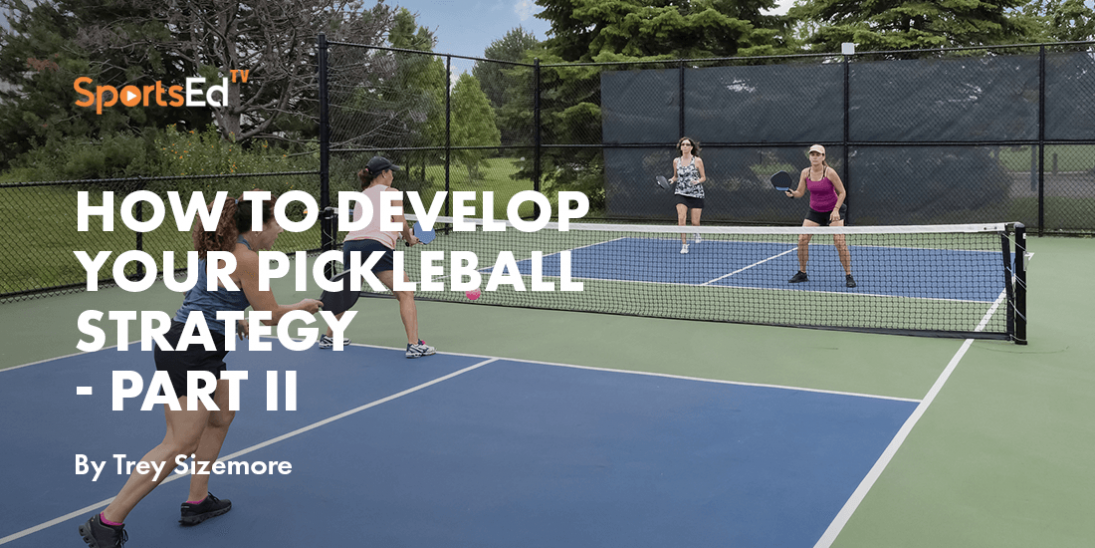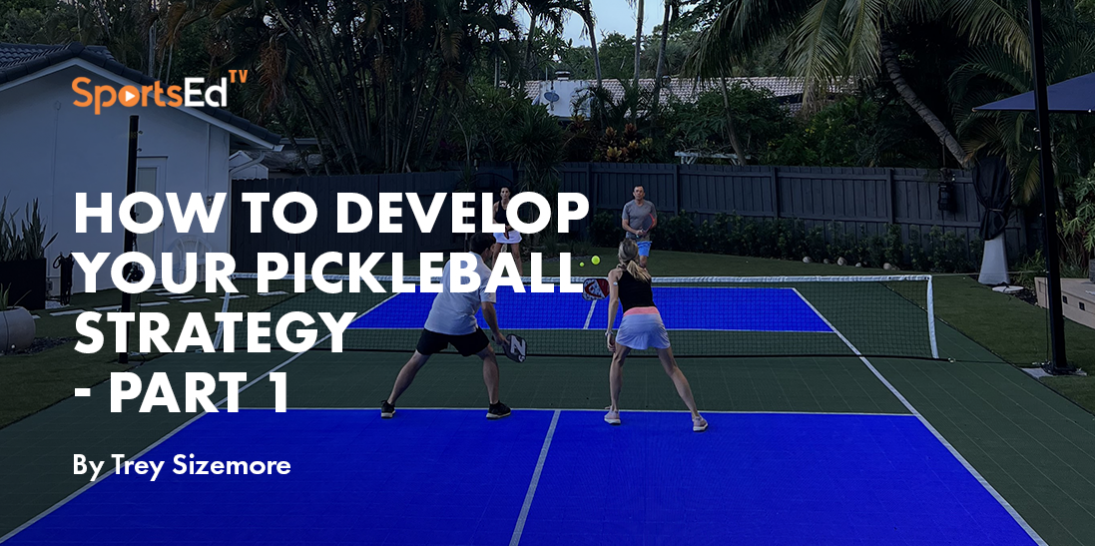Pickleball
Welcome and thanks for visiting...

7 Proven Strategies to Win More Pickleball Doubles Games

Pickleball doubles has exploded in popularity, captivating players of all ages and skill levels with its fast-paced, exciting gameplay. As a pickleball coach, player, and partner (with Helle Sparre) in the Dynamite Doubles for Pickleball online course, I've had the privilege of helping countless players elevate their performance and achieve their goals on the court. Through my experience, I've identified 7 essential strategies that can help you win more games and dominate your opponents. In this guide, we'll dive into each strategy, providing you with the knowledge you need to take your pickleball doubles game to the next level.
Strategy 1: Master the Third Shot Drop
The third shot drop is a game-changer (and ‘equalizer) in pickleball doubles. This shot involves gently dropping your opponent’s return into their kitchen, neutralizing their positional advantage (as the return team) and giving your team (the serving team) a chance to ‘get to even’. To execute a great third shot drop, focus on three key elements: grip, timing, and placement. Use a soft, relaxed grip to absorb the ball's energy and generate a gentle, arcing trajectory. The third shot drop is easiest to hit on a return that is middle to deep in your court. Hit the ball at its apex, when it's at its highest point, to maximize control and minimize the risk of hitting the net. Aim for the middle of your opponents' kitchen, forcing them to hit up on their next shot and giving your team an opportunity to attack.
Mastering the third shot drop takes practice, but the benefits are worth the effort. By consistently executing this shot when the opportunity arises, you'll keep your opponents on the defensive, create more offensive opportunities for your team, and ultimately win more points. Incorporate third-shot drop drills into your practice sessions, focusing on consistency and placement.
Strategy 2: Communicate Effectively with Your Partner
In pickleball doubles, communication is king. Your success on the court depends on your ability to work seamlessly with your partner, anticipating each other's movements and making split-second decisions together. Develop a clear system of hand signals and verbal cues to communicate your intentions and avoid confusion. Use simple, concise phrases like "mine," "yours," or "let it go" to indicate who will take the next shot. Establish a code for different plays, such as "stack" or "switch," so you can quickly adapt to different situations.
Effective communication extends beyond just calling shots. Take the time to discuss strategy with your partner before and during the game. Identify your strengths and weaknesses as a team, and develop a game plan that plays to your advantage. Celebrate your successes together and offer constructive feedback when things don't go as planned. Building a strong, supportive partnership is essential to winning more games.
Strategy 3: Utilize Smart Shot Selection
In pickleball doubles, every shot counts. You need to make smart decisions about when to play defensively and when to attack to win more points. Focus on hitting high-percentage shots that allow you and your partner to defend 100% of your court and minimize the risk of unforced errors. Deep returns and cross-court dinks are excellent options for maintaining control of the point and forcing your opponents to hit up on their next shot.
Adapt your shot selection based on your opponents' positioning and tendencies. If you notice that one of your opponents has a weak backhand, exploit that weakness by targeting that side of the court. If your opponents tend to hit short returns, be prepared to attack those shots with a powerful drive or a well-placed volley. Continuously analyze your opponents' play style and adjust your strategy accordingly.
Strategy 4: Implement Stacking and Switching
Stacking and switching are advanced strategies that can give you a significant advantage on the pickleball court and allow you and your partner to play to your strengths. For example, when stacking as the serving team, partners begin on the same side of the court, and then the server will advance to the opposite side after the serve. This would allow for the server to play on the side of the court they feel most comfortable most of the time. You can also stack as the receiving team.
Switching involves partners starting in their ‘normal’ positions and then swapping positions after the serve or return of serve. This strategy can be particularly effective when you have a right-handed and a left-handed player on your team. By switching, you create more favorable matchups and force your opponents to adjust their shots. Switching can also be used to confuse your opponents and disrupt their rhythm.
To implement stacking and switching effectively, practice these formations in your training sessions. Develop a clear understanding of each player's role and responsibilities, and communicate your intentions to your partner. Be prepared to adapt your strategy based on your opponents' reactions and the flow of the game.
Strategy 5: Capitalize on Reset Opportunities
Reset shots are a crucial tool in your pickleball doubles arsenal. These shots are designed to help you regain control of the point when you're in a defensive position. Common reset shot opportunities include deep triangles (hitting the ball deep and wide into your opponents' court) and kitchen resets (dropping the ball softly into the kitchen when you're pushed back from the non-volley zone).
To execute effective reset shots, focus on depth and placement. When hitting a deep triangle, aim for the corners of the court, making it difficult for your opponents to attack. When hitting a kitchen reset, use a soft touch and aim for the middle of the kitchen, giving your team time to reposition and prepare for the next shot.
Incorporate reset shot drills into your practice sessions, focusing on consistency and precision. The more comfortable you become with these shots, the more effectively you'll be able to neutralize your opponents' attacks and regain the upper hand in the point. Get comfortable with hitting your reset targets from anywhere on the court.
Strategy 6: Improve Your Transition Game
The Transition Zone, located just behind the non-volley zone and a few feet before the baseline, is a critical area in pickleball doubles. This is where many points are won and lost as teams battle to get to neutral and then gain the offensive advantage. Improving your movement and positioning in the Transition Zone will help you quickly shift from defense to offense and put pressure on your opponents.
To enhance your transition game, focus on three key elements: half volleys, split steps, and quick reactions. Practice drills that involve hitting half volleys from the Transition Zone to get comfortable working from here. Incorporate split steps into your footwork, allowing you to change direction quickly and efficiently. Work on reacting quickly to your opponent's shots, anticipating where the ball will land, and moving to that spot early.
As you improve your transition game, you'll find that you're able to put more pressure on your opponents, forcing them to hit more difficult shots and creating more opportunities for your team to advance up to the NVZ and eventually attack.
Strategy 7: Develop a Strong Mental Game
Pickleball doubles is a highly mental sport. Your ability to stay focused, composed, and confident under pressure often can be the difference between winning and losing. Developing a strong mental game is as important as honing your physical skills.
To build mental toughness, start by focusing on what’s going on right now. Don't dwell on past mistakes, and don’t worry about future points. Stay engaged in the current point, giving it your full attention and effort. Maintain a positive attitude, even when things aren't going your way. I know that can be easier said than done, but like many things, you can get better at this by staying in the moment and being self–aware if you hear the negative self-talk in your head. Celebrate your successes and learn from your mistakes, using them as opportunities to grow and improve.
Develop a pre-serve routine to help you stay centered and focused. Take a few deep breaths, visualize a successful serve, and repeat a positive affirmation to yourself. During the game, use positive self-talk to stay motivated and confident. Encourage your partner and work together to create a supportive, uplifting team dynamic.
Winning more games in pickleball doubles requires a combination of technical skills, strategic thinking, and mental toughness. By implementing these seven proven strategies, you'll be well on your way to becoming a formidable force on the pickleball court.
Remember, improvement is a journey, not a destination. Stay committed to your goals, practice regularly, and continuously seek out new learning opportunities. Surround yourself with supportive teammates and coaches who share your passion for the game and drive to succeed.
As you incorporate these strategies into your gameplay, be patient with yourself and celebrate your progress along the way. With dedication, perseverance, and a winning mindset, you'll be amazed at how quickly your pickleball doubles skills improve. So get out there, have fun, and start dominating the court like never before!








